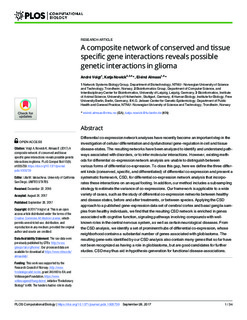| dc.contributor.author | Voigt, Andre | |
| dc.contributor.author | Nowick, Katja | |
| dc.contributor.author | Almaas, Eivind | |
| dc.date.accessioned | 2017-11-27T15:41:44Z | |
| dc.date.available | 2017-11-27T15:41:44Z | |
| dc.date.created | 2017-10-31T14:41:30Z | |
| dc.date.issued | 2017 | |
| dc.identifier.citation | PloS Computational Biology. 2017, 13(9); e1005739 | nb_NO |
| dc.identifier.issn | 1553-734X | |
| dc.identifier.uri | http://hdl.handle.net/11250/2468176 | |
| dc.description.abstract | Differential co-expression network analyses have recently become an important step in the investigation of cellular differentiation and dysfunctional gene-regulation in cell and tissue disease-states. The resulting networks have been analyzed to identify and understand pathways associated with disorders, or to infer molecular interactions. However, existing methods for differential co-expression network analysis are unable to distinguish between various forms of differential co-expression. To close this gap, here we define the three different kinds (conserved, specific, and differentiated) of differential co-expression and present a systematic framework, CSD, for differential co-expression network analysis that incorporates these interactions on an equal footing. In addition, our method includes a subsampling strategy to estimate the variance of co-expressions. Our framework is applicable to a wide variety of cases, such as the study of differential co-expression networks between healthy and disease states, before and after treatments, or between species. Applying the CSD approach to a published gene-expression data set of cerebral cortex and basal ganglia samples from healthy individuals, we find that the resulting CSD network is enriched in genes associated with cognitive function, signaling pathways involving compounds with wellknown roles in the central nervous system, as well as certain neurological diseases. From the CSD analysis, we identify a set of prominent hubs of differential co-expression, whose neighborhood contains a substantial number of genes associated with glioblastoma. The resulting gene-sets identified by our CSD analysis also contain many genes that so far have not been recognized as having a role in glioblastoma, but are good candidates for further studies. CSD may thus aid in hypothesis-generation for functional disease-associations. | nb_NO |
| dc.language.iso | eng | nb_NO |
| dc.publisher | Public Library of Science | nb_NO |
| dc.rights | Navngivelse 4.0 Internasjonal | * |
| dc.rights.uri | http://creativecommons.org/licenses/by/4.0/deed.no | * |
| dc.title | A composite network of conserved and tissue specific gene interactions reveals possible genetic interactions in glioma | nb_NO |
| dc.type | Journal article | nb_NO |
| dc.type | Peer reviewed | nb_NO |
| dc.description.version | publishedVersion | nb_NO |
| dc.source.volume | 13 | nb_NO |
| dc.source.journal | PloS Computational Biology | nb_NO |
| dc.source.issue | 9 | nb_NO |
| dc.identifier.doi | 10.1371/journal.pcbi.1005739 | |
| dc.identifier.cristin | 1509418 | |
| dc.relation.project | Norges forskningsråd: 245160 | nb_NO |
| dc.description.localcode | © 2017 Voigt et al. This is an open access article distributed under the terms of the Creative Commons Attribution License, which permits unrestricted use, distribution, and reproduction in any medium, provided the original author and source are credited. | nb_NO |
| cristin.unitcode | 194,66,15,0 | |
| cristin.unitcode | 194,65,20,0 | |
| cristin.unitname | Institutt for bioteknologi og matvitenskap | |
| cristin.unitname | Institutt for samfunnsmedisin og sykepleie | |
| cristin.ispublished | true | |
| cristin.fulltext | original | |
| cristin.qualitycode | 2 | |

